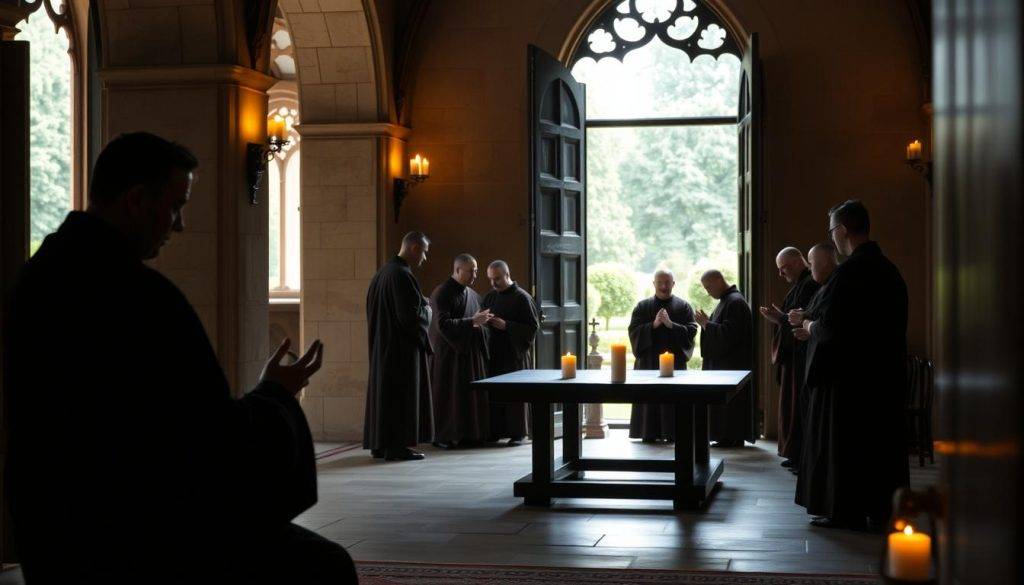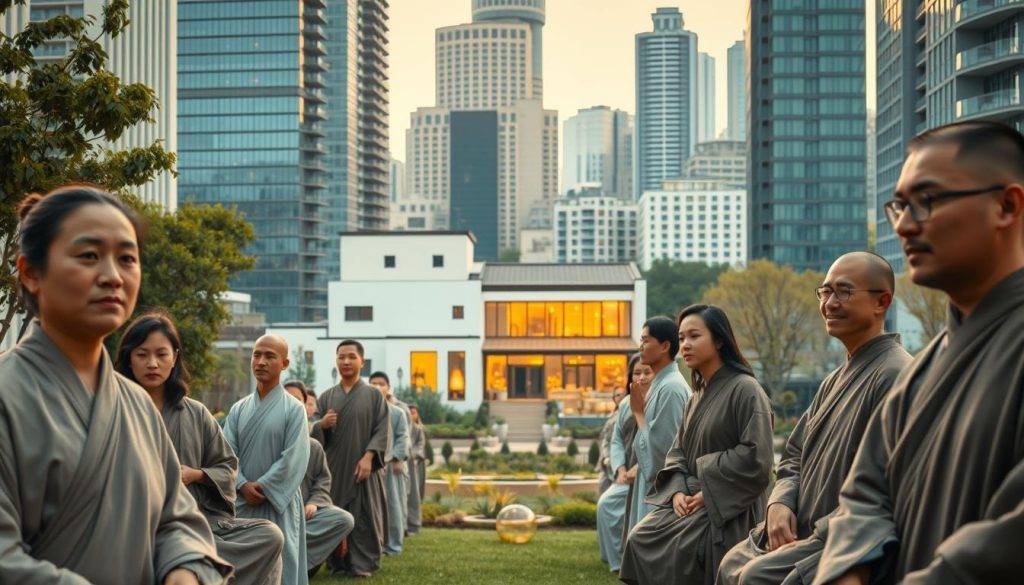“The monk is not a man who says prayers, but a man who has become prayer.” — Thomas Merton’s words capture the essence of a lifestyle that has shaped spiritual traditions for millennia. Rooted in ancient traditions like Buddhism and Christianity, monasticism represents a deliberate choice to prioritize inner growth over external distractions. Its principles—simplicity, discipline, and community—offer timeless tools for navigating modern chaos.
From the desert hermits of early Christianity to Buddhist monasteries in the Himalayas, this way of life emphasizes renouncing materialism to cultivate presence. Rules like St. Benedict’s “ora et labora” (pray and work) blended structured routines with spiritual reflection, creating frameworks still studied today. Whether through solitary asceticism or communal living, these traditions share a focus on transcending ego-driven desires.
But why does this matter now? The answer lies in monasticism’s ability to foster mental clarity and resilience. By integrating practices like mindful reading, intentional silence, and shared rituals, individuals reclaim agency over their inner worlds. This isn’t about religion—it’s about harnessing proven methods to thrive amid societal noise.
Key Takeaways
- Monastic traditions date back thousands of years, emphasizing simplicity and self-discipline across cultures.
- Communal and solitary forms coexist, tailored to different spiritual goals and temperaments.
- Structured routines, like those in St. Benedict’s Rule, balance work, study, and reflection.
- Core practices—such as meditation or manual labor—cultivate focus and emotional stability.
- Modern applications of these principles can enhance personal growth without requiring religious commitment.
Introduction to Monastic Practice
At its core, this tradition centers on reshaping one’s relationship with time and purpose. Ancient communities structured their days around rhythms of work, reflection, and connection—principles still relevant today. Whether through Buddhist sanghas or Christian monasteries, these frameworks teach how intentional habits create lasting inner change.

Early followers lived by strict codes emphasizing simplicity. Benedictine rules divided hours into prayer, manual labor, and lectio divina—a meditative reading method. Buddhist monks mirrored this balance with chanting, alms collection, and mindfulness exercises. Both systems prioritized accountability to a group, proving discipline thrives alongside shared goals.
| Practice | Christian Tradition | Buddhist Tradition |
|---|---|---|
| Prayer/Meditation | Liturgical hours | Vipassana sessions |
| Work | Farming, brewing | Gardening, cooking |
| Study | Scriptural reading | Sutra memorization |
| Community | Chapter meetings | Dharma talks |
Modern adaptations focus on accessibility. You don’t need robes or vows to benefit. Setting aside 20 minutes daily for contemplative reading—or replacing screen time with mindful walks—can mirror monastic rhythms. As theologian Richard Rohr notes: “Rituals slow us down until we see what’s always been there.”
This approach isn’t about escaping the world. It’s about engaging it with renewed clarity. By borrowing ancient strategies, anyone can craft a life less ruled by distractions and more aligned with meaning.
Historical Roots of Monastic Living
Structured spiritual living emerged independently across continents, shaping societies through shared values. While Western traditions formalized communal rules, Eastern systems refined ascetic techniques—both seeking harmony between inner growth and outer contribution.

Christian Heritage and the Rule of St Benedict
Sixth-century Italy saw Benedict of Nursia codify guidelines for balanced spirituality. His Rule organized daily life into eight prayer periods, manual labor, and scriptural study. This framework replaced solitary hermit lifestyles with cooperative communities. “Idleness is the enemy of the soul,” he wrote, emphasizing purposeful routines.
Benedictine monasteries became medieval Europe’s intellectual hubs. They preserved classical texts while advancing agriculture and education. This blend of work and contemplation formed a blueprint still used by religious institutions today.
Eastern Traditions and Early Buddhist Practices
In ancient India, Buddha’s followers adopted minimalist lifestyles to deepen awareness. They traveled in groups, relying on alms while practicing detachment. Unlike Christian orders, these communities emphasized individual meditation over structured rituals.
Key principles included:
- Non-attachment to material possessions
- Mindfulness during daily activities
- Ethical conduct as spiritual foundation
| Aspect | Christian Model | Buddhist Model |
|---|---|---|
| Focus | Community obedience | Personal enlightenment |
| Primary Text | Bible | Pali Canon |
| Legacy | Western education systems | Mindfulness movements |
Both traditions prove structured spirituality adapts across cultures. Their historical innovations continue influencing modern self-development methods—from silent retreats to digital detox practices.
Deep Dive into Monastic Practice: Celibacy, Solitude, and Asceticism
Three pillars—celibacy, solitude, and asceticism—formed the bedrock of spiritual commitment across ancient traditions. These choices weren’t about deprivation but about creating space for undistracted self-awareness. By removing distractions, individuals could confront ego-driven patterns and cultivate lasting inner freedom.
Foundational Principles and Spiritual Philosophy
Celibacy allowed monks to redirect energy from relationships toward introspection. Early Christian hermits like Anthony of Egypt retreated to deserts, believing isolation clarified divine connection. Similarly, Buddhist ascetics avoided attachments to deepen mindfulness. Solitude became a mirror—reflecting truths obscured by societal noise.
![]()
Asceticism shaped daily rhythms through simplicity. Saint Benedict’s Rule mandated plain diets, limited possessions, and manual labor. This wasn’t punishment—it trained focus. As theologian Evagrius Ponticus wrote: “The monk’s cell teaches patience; poverty teaches gratitude.” Such discipline aimed to dissolve selfish desires, aligning actions with higher purpose.
The Influence of Saint Benedict and Medieval Traditions
Benedict’s sixth-century guidelines transformed spiritual living. His balanced approach—prayer, work, study—prevented extremes while fostering resilience. Monasteries became hubs where celibacy and communal accountability coexisted. This model spread across Europe, shaping education and ethics during the Middle Ages.
| Practice | Benedictine Approach | Other Ascetic Traditions |
|---|---|---|
| Celibacy | Vowed commitment | Optional for lay Buddhists |
| Solitude | Structured retreats | Cave-dwelling hermits |
| Asceticism | Moderate fasting | Extreme self-denial in Desert Fathers |
Today, these principles offer frameworks for mental clarity. Reducing screen time mirrors solitude; mindful consumption echoes asceticism. As Benedict showed, structured discipline—not rigidity—creates space for growth.
Core Principles and Daily Discipline
Daily rhythms in spiritual communities blend structure with introspection—a dance between focused action and quiet reflection. This balance transforms routine into ritual, turning ordinary moments into pathways for growth.

Practices of Lectio Divina and Meditation
Lectio divina, meaning “divine reading,” follows four steps:
- Lectio: Slowly reading a sacred text
- Meditatio: Reflecting on its personal meaning
- Oratio: Responding through silent prayer
- Contemplatio: Resting in deepened awareness
This method, used for centuries, cultivates clarity by engaging both mind and heart. As theologian Eugene Peterson noted: “Scripture is meant to be digested, not just studied.”
Meditation complements this through breath-focused stillness. Regular sessions reduce mental clutter, creating space for intuitive insights. Research shows even 10 minutes daily lowers stress hormones while boosting focus—a modern parallel to ancient practical mysticism.
Mindful Presence and Community Life
Structured routines anchor these practices. Dawn meditation primes the mind, while shared meals reinforce connection. Evening reflection circles allow members to process experiences together.
| Morning | Evening |
|---|---|
| Silent meditation | Gratitude sharing |
| Lectio divina | Group chanting |
| Manual work | Journaling |
Communal living amplifies individual efforts. Accountability partners encourage consistency, while group rituals—like synchronized prayer—create collective energy. As Zen teacher Thich Nhat Hanh taught: “The most precious gift we can offer is our presence.”
These time-tested strategies prove discipline isn’t restrictive—it’s liberating. By designing days around intentional habits, anyone can cultivate resilience amid life’s chaos.
Monastic Practices Across Religions
Spiritual communities worldwide share a common thread—using disciplined living to transcend earthly attachments. While methods vary, traditions from Buddhism to Jainism reveal core principles that bridge cultural divides. These systems prove inner transformation thrives through intentional habits, whether in bustling monasteries or solitary forest retreats.

Buddhist and Taoist Approaches
Buddhist communities prioritize harmony between meditation and daily tasks. Monks follow the Vinaya Pitaka, a code governing everything from mealtime etiquette to conflict resolution. Work becomes meditation—sweeping courtyards or preparing meals with mindful attention.
Taoist traditions emphasize aligning with nature’s rhythms. Monasteries often nestle in mountains, blending physical labor with breathing exercises. As philosopher Lao Tzu wrote: “Nature does not hurry, yet everything is accomplished.” Both systems balance structure with spontaneity.
Hindu Renunciation and Jain Asceticism
Hindu sannyasa involves complete renunciation of possessions and social ties. Wanderers carry only a bowl and staff, relying on alms while seeking self-realization. In contrast, Jain ascetics follow extreme non-violence—filtering water to avoid harming microbes.
| Aspect | Buddhist/Taoist | Hindu/Jain |
|---|---|---|
| Community Life | Structured monasteries | Solitary or small groups |
| Focus | Mindful routines | Radical detachment |
| Key Discipline | Meditation hours | Fasting protocols |
Despite differences, all paths value simplicity. Buddhist nuns chant sutras at dawn; Jain monks recite mantras while walking barefoot. These rituals—steeped in centuries of tradition—offer blueprints for cultivating presence amid modern distractions.
The Spiritual Discipline of Lectio Divina
Lectio Divina—Latin for “divine reading”—transforms scripture engagement from analysis to intimate dialogue. Unlike casual reading, this four-step rhythm invites you to absorb sacred texts through receptive listening rather than intellectual dissection. Its circular flow mirrors breathing: inhaling wisdom, exhaling reflection.

Monastic Method vs. Scholastic Approach
Traditional Lectio Divina prioritizes experiential connection over academic rigor. Monastic practitioners followed a fluid pattern:
- Lectio: Reading a passage slowly, letting phrases resonate
- Meditatio: Allowing words to interact with personal experiences
- Oratio: Responding through spontaneous prayer
- Contemplatio: Resting in silent awareness of divine presence
Scholastic adaptations later emphasized logical analysis—dissecting texts for theological debates. This shift turned scripture into a subject rather than a mirror for self-discovery. As mystic Teresa of Ávila observed: “Prayer is not about thinking much, but loving much.”
Experiencing Contemplative Prayer and Receptive Listening
True Lectio Divina thrives in repetition. Reading Psalm 23 ten times slowly yields deeper layers than skimming ten chapters. Silence becomes the fertile ground where insights emerge organically. A Benedictine guide advises: “Let the text read you—discover what stirs your heart, not just your mind.”
| Aspect | Monastic Method | Scholastic Approach |
|---|---|---|
| Focus | Heart-centered listening | Intellectual analysis |
| Pace | Slow, cyclical | Linear, goal-oriented |
| Outcome | Inner transformation | Theological knowledge |
To practice today: Set aside 15 minutes. Choose a short text—like Matthew 6:26 (“Look at the birds…”). Read it aloud three times, pausing after each repetition. Notice which words linger. Journal reflections without editing. This simple process cultivates what early Christians called “the ear of the heart.”
Modern Monasticism: Relevance in Today’s World

In bustling cities and digital workspaces, ancient rhythms of contemplation are finding new life. Communities like the New Monastic Movement blend Benedictine principles with urban activism—running food banks while maintaining daily lectio divina sessions. Their members prove spiritual discipline isn’t confined to remote abbeys but thrives in apartment complexes and coworking spaces.
Adapted practices meet modern needs:
- Silent retreats replace medieval cloisters with weekend workshops on mindful leadership
- Apps like Hallowed digitize scripture meditation, making lectio divina accessible during commutes
- Ecumenical groups like Taizé use chanting to foster unity in divided societies
Research shows 12 minutes of sacred text reflection daily lowers cortisol levels by 18%. This explains why CEOs and teachers alike adopt modified asceticism—like fasting from social media every day. As author Shane Claiborne notes: “We’re not escaping the world but engaging it with rooted compassion.”
| Traditional Practice | Modern Adaptation |
|---|---|
| Monastic vows | Year-long mindfulness pledges |
| Manual labor | Gardening therapy programs |
| Chapter meetings | Accountability masterminds |
Organizations like the World Community for Christian Meditation exemplify this shift. Their 130,000 members across 114 countries meet virtually, proving structured spirituality transcends physical institutions. In a secular age, these frameworks offer what smartphones can’t—time-tested tools to reclaim attention and purpose.
Societal Impact of Monastic Institutions
For over 1,500 years, spiritual communities have shaped civilizations by safeguarding knowledge and fostering social cohesion. Their influence extends far beyond religious circles, leaving indelible marks on education, art, and civic engagement.

Cultural Preservation and Educational Contributions
Medieval European monasteries served as early universities. Monks meticulously copied ancient Greek texts and illuminated manuscripts, preserving philosophy and science during turbulent times. Buddhist monastic communities in Asia similarly protected regional languages by translating scriptures into local dialects.
| Era | Cultural Role | Educational Innovation |
|---|---|---|
| 8th-12th Century | Scriptoriums preserved classical literature | Developed standardized curricula |
| 13th-16th Century | Promoted vernacular literature | Established cathedral schools |
| 21st Century | Digital archiving projects | Mindfulness programs in universities |
These groups also pioneered structured learning. Benedictine rules inspired modern boarding schools’ schedules, blending study with hands-on work. Today, Tibetan monks teach neuroscience researchers about meditation’s cognitive benefits.
Community Building and Social Outreach
From feeding the poor to mediating conflicts, spiritual institutions have long addressed societal needs. Medieval Christian monasteries built Europe’s first hospitals, while Buddhist temples provided shelter during monsoons.
Modern adaptations continue this legacy:
- Urban Zen centers offer addiction recovery programs
- Ecovillages model sustainable living inspired by ascetic principles
- Interfaith groups host dialogue circles to reduce polarization
A 2022 Harvard study found neighborhoods with active spiritual communities report 23% higher volunteer rates. This enduring impact proves disciplined groups can drive meaningful change—one compassionate act at a time.
Conclusion
Throughout history, seekers have turned to disciplined living to unlock deeper truths—not by rejecting the world, but by engaging it with renewed purpose. From Benedictine communities preserving knowledge to Buddhist monks refining mindfulness, these traditions evolved across eras while maintaining core values: simplicity, focus, and collective growth.
Modern adaptations prove their timeless relevance. Structured routines—like lectio divina—still cultivate mental clarity. A 2023 study found those practicing sacred text reflection daily reported 27% higher emotional resilience. Whether through silent retreats or digital detoxes, these forms help reclaim attention in distracted times.
Beyond personal benefits, spiritual institutions shaped societies. Medieval monasteries advanced education; today’s urban movements address food insecurity. Their legacy reminds us that inner work fuels outward impact.
Consider integrating small shifts: morning meditation replaces scrolling, or weekly volunteer hours mirror communal service. As the Desert Fathers showed, transformation begins with one intentional way forward. What example from history could inspire your next step toward purpose?
FAQ
How do monastic principles apply to modern life?
Timeless practices like mindful presence, structured routines, and intentional community-building offer frameworks for reducing distractions and cultivating purpose. Many adapt these methods through meditation, digital detoxes, or volunteer work to align daily actions with deeper values.
What role does celibacy play in spiritual growth?
Celibacy fosters focus by redirecting energy from relational commitments to inner reflection and service. While not universal—some traditions allow marriage—it’s seen as a tool for deepening devotion and detachment from worldly desires in certain paths.
How does lectio divina differ from regular reading?
Unlike analytical study, lectio divina emphasizes contemplative engagement. Practitioners slowly absorb sacred texts through four stages—reading, reflection, prayer, and stillness—allowing insights to emerge organically rather than seeking intellectual mastery.
Why do monasteries emphasize communal living?
Shared routines create accountability and mirror interconnectedness. Tasks like communal meals or group prayer reinforce humility, mutual support, and the idea that spiritual progress thrives in relationships, not isolation.
What contributions have monastic groups made to society?
They’ve preserved manuscripts, advanced agriculture, and provided education and healthcare for centuries. Modern institutions continue this legacy through interfaith dialogue, environmental activism, and offering retreats for mental wellness.
Can non-religious individuals benefit from these practices?
Absolutely. Techniques like meditation, mindful work, or journaling draw from monastic traditions without requiring religious adherence. The focus is on cultivating awareness, discipline, and ethical living—universal goals across belief systems.
How did Saint Benedict shape Western monasticism?
His 6th-century Rule balanced prayer, labor, and study, rejecting extreme asceticism. This “middle way” framework became the blueprint for Christian communities, emphasizing stability, obedience, and gradual transformation through daily habits.




























































